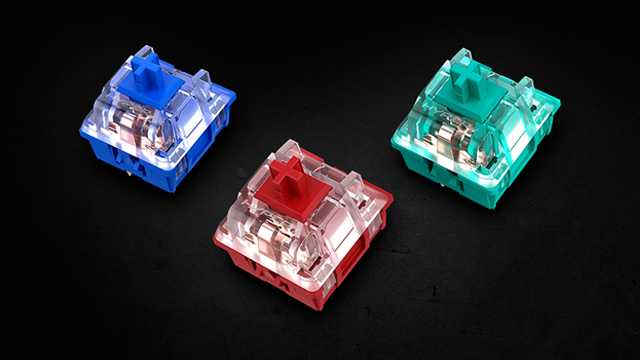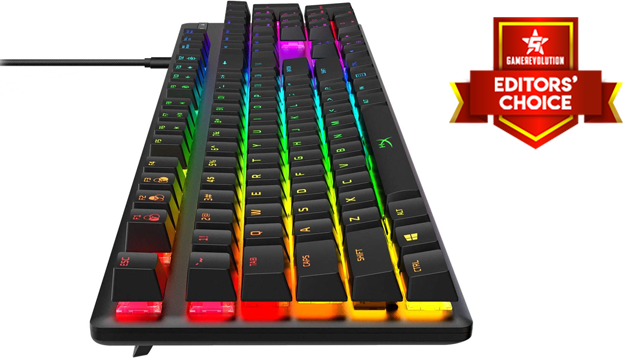I’m typing this HyperX Alloy Origins review using the keyboard in question, and its satisfying “click” with each push of a key reassures me that the high praise I’m about to give is justified. You see, I really do love this new mechanical keyboard from HyperX. While it’s not perfect, and I’ll absolutely be detailing the negatives points, the Alloy Origins has ultimately won me over by ticking essential boxes like build quality, responsiveness and overall feel, and also RGB implementation. Read on for my full thoughts after three weeks of use, during which I’ve worked and gamed in bliss.
HyperX Alloy Origins Review | Supreme quality

Let’s start simple, with what’s in the box. As with many other HyperX products, the unboxing experience is pretty standard and with little in the way of drama or surprises. You get the Alloy Origins keyboard protected by a plastic wrap, a decently long USB cable, and a quickstart guide. It’s as barebones as it gets, which I am honestly fine with. The omission of a keycap puller and other common accessories may irk some users, however. The USB cable measures 1.8m in length and is braided to help increase durability and avoid tangling. It plugs into the keyboard using the modern Type-C connection, which is great to see. What’s more, the laptop’s USB port is recessed a little, meaning additional protection for the Type-C connector, which can be prone to bending. It’s minor, but still worthy of mention, as HyperX has gone the extra mile here.
ALSO: HyperX Pulsefire Dart Review | Wonderfully wireless
Upon lifting the keyboard for the first time, I was immediately surprised by just how heavy the Alloy Origins is. This is one hell of a weighty lad. I’ll admit that when I first heard about the “full aircraft-grade aluminum body,” I was skeptical at just how big of an impact this would make to the overall feel and use of the keyboard. Any doubts I had went out of the window when I picked it up and placed it on my desk. The build quality of the frame is seriously top-tier, many levels above the lighter, plastic frames that I’ve been using. Sure, the 2.4 lbs weight will be a disadvantage for those planning to travel with this keyboard, but its heft is a big advantage in the home and/or office. Right from the get-go, the Alloy Origins oozes quality, which made for a great first impression.

While the frame feels incredible, the keycaps are pretty average, and hardcore keyboard enthusiasts will likely want to swap these out for something of a higher quality after a year or so of use. For the price, however, I think they are acceptable and should resist finger grease and marks for some time. I’m hoping that HyperX begins to implement its own Double Sot PBT keycaps with the “pudding” layer, which have the added benefit of enhancing RGB output.
Buy a HyperX Alloy Origins keyboard here
Though its weight may make it a chore to carry in a backpack, the Alloy Origins’ overall size and footprint are pretty compact. It’s a full-sized keyboard that doesn’t take up as much room as you might be expecting. This is a big win for those with limited desk space, but who still want a keyboard that boasts a number pad. It’s heavy, but it’s not unnecessarily chunky or suboptimal in its use of space, which is fantastic.
HyperX Alloy Origins Review | Do it yourself

The next unique selling point of the Alloy Origins keyboard is that it uses HyperX’s own mechanical switches. My version came with the “HyperX Reds,” which appear to be an attempt at an improved version of the CHERRY MX Reds. HyperX’s version has the same operating force, and a very similar actuation point and total travel distance. (The 0.2 mm differences here were imperceptible by me, and I imagine most won’t be able to tell the difference.)
Honestly, I’ve been using CHERRY MX Reds in my primary keyboard for the past six months, and the HyperX Reds feel the same. They may sound a little different, but otherwise I can’t tell the difference. I think that this is another big win for HyperX, as the company can now focus on using its own switches, potentially lowering the cost of overall production and hopefully passing those savings on to the consumer.
HyperX Alloy Origins Review | Shine bright like a keyboard

Ever since I reviewed the Alloy Elite RGB last year, it’s been clear that HyperX knows what it is doing with RGB lighting. When it wants a keyboard to shine, it makes it shine bright. Though it doesn’t have “RGB” in its name, the Alloy Origins is also a blindingly bright beast, with vibrant colors that can be customized per key. While other keyboards can suffer from being too dim, the Alloy Origins has the opposite problem, and I had to actually turn the brightness down when playing games in a dark room. Thankfully, quick changes to brightness are easily carried out through shortcut keys.
Speaking of shortcut keys, one of the bigger downsides this keyboard has, especially when coming from something like the Alloy Elite RGB, is the lack of dedicated media controls and a volume wheel. I think HyperX cut these to allow for a smaller footprint, and overall I do think this sacrifice was worth it, but it’s important that those who are considering a purchase know what they are getting themselves into. Media controls are instead assigned as F-key shortcuts, which will likely be an acceptable compromise.
HyperX Alloy Origins Review | Checking the boxes

Other great-to-see features include the adjustable height, which has three different angles, all equipped with rubber feet to prevent slipping; room for three different profiles in the keyboard’s onboard memory, which are great for multiple different users or when switching between games; an easy-to-activate Game Mode, which is configurable to deactivate a number of different keys when in-game; and 100% anti-ghosting and N-key rollover functionalities to make the gaming and typing experiences consistent and as frustration-free as possible.
Overall, this keyboard checks all of the boxes on my “must-have features list.”
HyperX Alloy Origins Review | Doing what it needs to do

I’ve already provided my thoughts on the current version of HyperX’s NGENUITY software in my Pulsefire Dart mouse review, and I have the same conclusion when using the app to customize the keyboard lighting and functions. It’s a little more cumbersome with the Alloy Origins, however, as there are a lot more options when it comes to different RGB effects and profiles. It took me a good 10-15 minutes to understand how to get profiles to save correctly, but ultimately it worked out fine. There’s definitely room for improvement when it comes to ease-of-use and making sure settings save properly.
This software also allows you to create macros, though there are no dedicated macro keys on the board itself. This means that some extra thought is required if you’re big into MMOs or other genres where macros are practically mandatory.
HyperX Alloy Origins Review | Choose your weapon

At $110, the HyperX Alloys Origins is priced well for the quality it offers and, if you don’t require the number pad, there’s the tenkeyless variant at $90. The TKL version takes the already small footprint and makes it even smaller, and is what I would personally go for. Overall, with its solid frame, great switches, fantastic RGB implementation, and functional software, the HyperX Alloys Origins range gets a big thumbs up from me, with this superb hardware earning our Editors’ Choice award. Definitely add this to your shortlist when deciding on your next keyboard!
HyperX Alloy Origins review unit was provided by HyperX.
When you click on a link from an online retailer on GameRevolution, we might earn a percentage of the value of your purchase. Learn more here.







